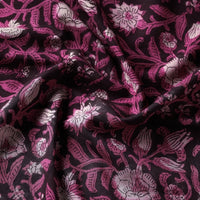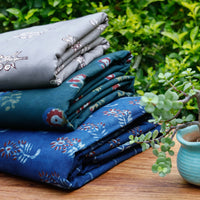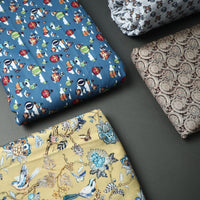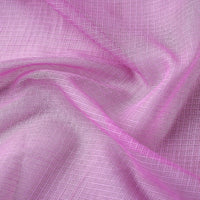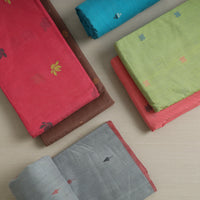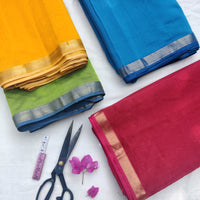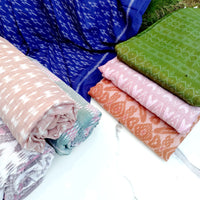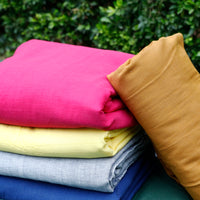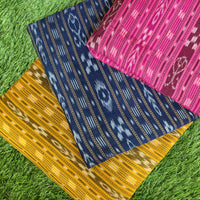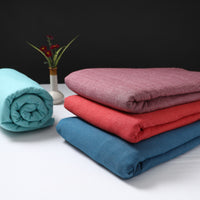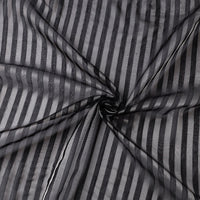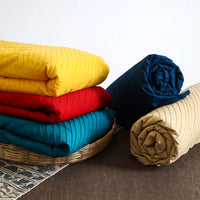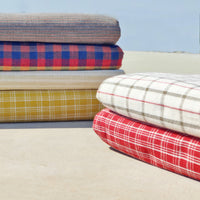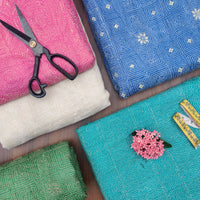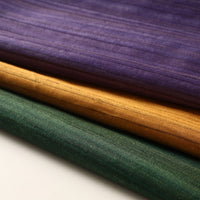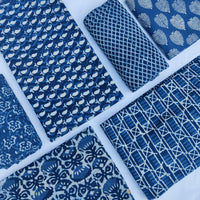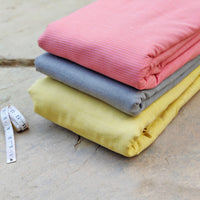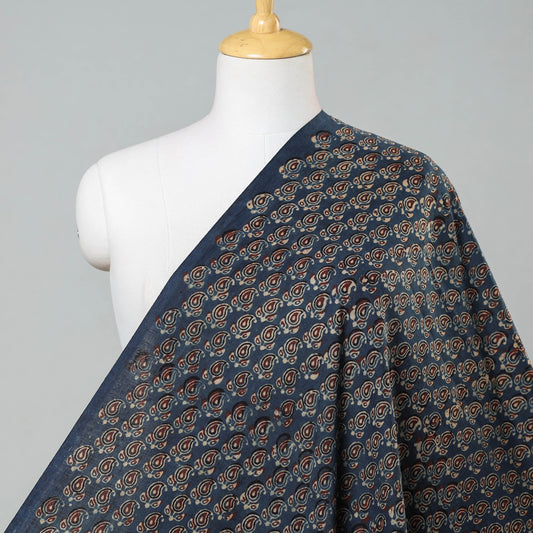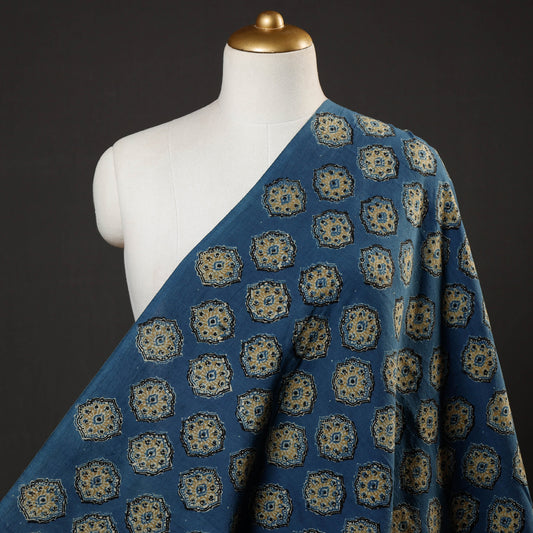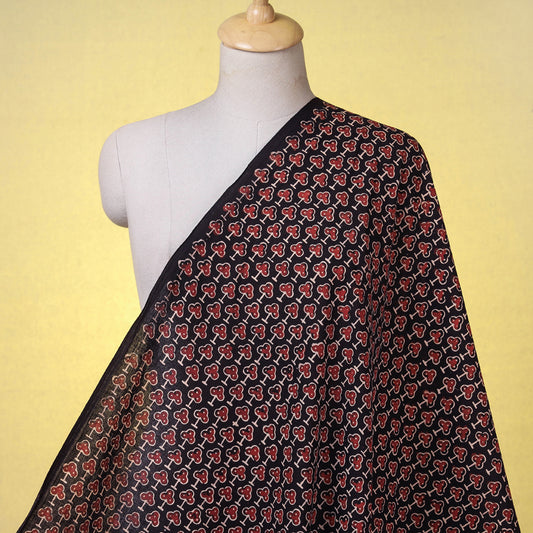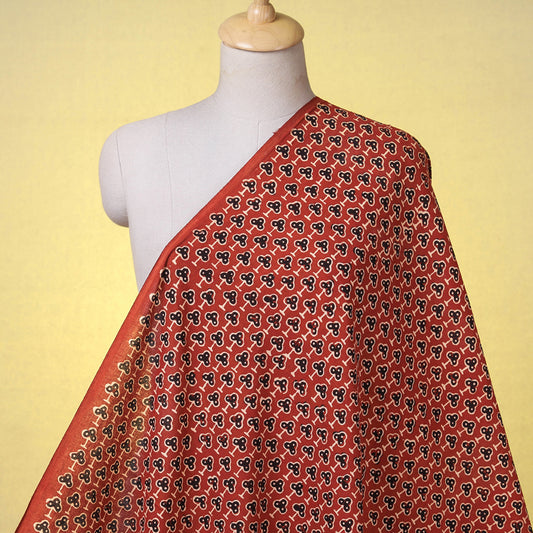The Legacy of Ajrakh: A Journey Through Time and Craft
Ajrakh is not just a fabric; it’s a cultural symbol, a living testimony to India’s rich history, and a craft that has been preserved and passed down through generations. The story of Ajrakh fabric begins over four millennia ago in the arid regions of Kutch, Gujarat, and Sindh, Pakistan. This ancient block-printing art form is deeply intertwined with the history, culture, and identity of the communities that practice it. Ajrakh has evolved over centuries, but it has remained a symbol of resilience, tradition, and artistic mastery.
The Artisans of Ajrakh: Masters of Craft and Culture
At the heart of Ajrakh's enduring legacy are the artisans—primarily the Khatri community—whose lives are dedicated to this intricate craft. The Khatris have been practicing Ajrakh printing for generations, with their skills honed and perfected over centuries. They are more than craftsmen; they are custodians of a heritage that dates back to the Indus Valley Civilization.
Ajrakh is a family affair, with knowledge passed down from one generation to the next. From a young age, children in these artisan families learn the secrets of the trade: how to mix natural dyes, carve wooden blocks, and master the complex processes that give Ajrakh its distinctive look. This craft is their identity, their livelihood, and their legacy.
The Region: Kutch and the Origins of Ajrakh
Kutch, in Gujarat, is a region marked by its stark landscapes, with vast salt flats, rolling sand dunes, and a harsh climate that is both challenging and beautiful. It is in this unique environment that Ajrakh was born. The region's isolation and the scarcity of resources led the people of Kutch to develop a self-sufficient way of life, relying on their creativity and resilience to survive.
The water in this region, rich in minerals, plays a crucial role in the dyeing process, giving Ajrakh fabric its vibrant hues and deep tones. The local flora, such as the indigo plant, also contributes to the natural dyes used in the fabric. These environmental factors, combined with the ingenuity of the artisans, have made Ajrakh fabric truly one of a kind.
Ajrakh: A Complex Craft Rooted in Tradition
Ajrakh printing is one of the most labor-intensive forms of textile production, requiring immense skill, patience, and precision. The process involves a series of steps—some say as many as 16—that must be meticulously followed to achieve the final product. These steps include washing, dyeing, printing, and drying the fabric multiple times, often taking several weeks to complete.
The blocks used for printing are intricately carved from teak wood, with each design representing a piece of the artisan's heritage. The patterns are often geometric, with intricate motifs that are carefully aligned to create a harmonious design. The symmetry and precision required in Ajrakh printing are a testament to the artisans' expertise and attention to detail.
The Natural Dyes of Ajrakh: A Commitment to Sustainability
One of the most remarkable aspects of Ajrakh is its use of natural dyes. These dyes are derived from a variety of plants, minerals, and natural sources, including indigo, pomegranate, and alum. The indigo plant, in particular, has a long history in India, with its deep blue color being one of the most sought-after shades in the world.
The use of natural dyes is not only a reflection of the artisans' connection to the land but also a commitment to sustainability. Unlike synthetic dyes, which can be harmful to the environment, natural dyes are biodegradable and non-toxic, making Ajrakh fabric an eco-friendly choice for conscious consumers.
Ajrakh and the Khatri Community: A Story of Survival and Revival
The history of Ajrakh is also a story of survival. In the mid-20th century, the craft faced a decline due to the rise of industrialization and mass-produced textiles. The painstaking process of creating Ajrakh fabric made it difficult for artisans to compete with cheaper, machine-made alternatives. Many artisans were forced to abandon their craft in search of more sustainable livelihoods.
However, the story of Ajrakh is also one of revival. In recent decades, there has been a renewed interest in traditional crafts, fueled by a growing awareness of the importance of cultural preservation and sustainable practices. Organizations and initiatives have emerged to support artisans, helping them to modernize their techniques while preserving the essence of the craft.
iTokri has been at the forefront of this movement, partnering directly with artisan communities to bring Ajrakh fabric to a global audience. By providing a platform for these artisans, iTokri is not only helping to preserve a centuries-old craft but also ensuring that the artisans can continue to practice their trade in a sustainable and economically viable way.
Human Interest Stories: The Faces Behind Ajrakh
Behind every piece of Ajrakh fabric lies a human story—a story of dedication, passion, and resilience. One such story is that of Abdul Rahim Khatri, a master craftsman from the village of Ajrakhpur in Kutch. Abdul Rahim comes from a long line of Ajrakh artisans, and his family has been practicing the craft for over 400 years. Despite the challenges posed by modernity and changing economic conditions, Abdul Rahim has remained committed to preserving the tradition of Ajrakh.
Through his work, Abdul Rahim has not only kept the craft alive but has also innovated within it, experimenting with new patterns and color combinations while staying true to the traditional methods. His dedication has earned him recognition both in India and abroad, and his work is now celebrated as a symbol of India's rich cultural heritage.
Another inspiring story is that of Fatima, a young woman from the same village who is breaking barriers by becoming one of the few female Ajrakh artisans. In a field traditionally dominated by men, Fatima has carved out a space for herself, learning the craft from her father and contributing her own unique touch to the designs. Her work is a testament to the evolving nature of Ajrakh and the ways in which tradition can be adapted to include new voices and perspectives.
The Cultural Significance of Ajrakh: A Fabric with a Soul
Ajrakh fabric is deeply embedded in the cultural fabric of the regions where it is produced. In Kutch, it is worn during important rituals and ceremonies, symbolizing purity, respect, and continuity with the past. The intricate patterns are often imbued with symbolic meanings, representing elements of nature, spirituality, and the cosmos.
For the Khatri community, Ajrakh is not just a source of income; it is a way of life. The craft is an expression of their identity, their connection to the land, and their respect for the traditions handed down by their ancestors. By wearing or displaying Ajrakh fabric, consumers become part of this rich cultural tradition, carrying forward the legacy of a craft that has survived for thousands of years.
iTokri: Championing Artisan Crafts and Sustainable Practices
iTokri’s commitment to promoting and preserving traditional crafts like Ajrakh is unmatched in the Indian e-commerce landscape. As India’s premier artisan craft platform, iTokri connects consumers around the world with over 500 artisan groups, offering a wide range of handcrafted products that celebrate India’s diverse cultural heritage.
At iTokri, authenticity is more than just a buzzword—it is a core value. Every product on the platform is guaranteed to be authentic and ethically sourced, with each purchase directly supporting the artisans who create them. This commitment to authenticity and trust has made iTokri a leader in the global marketplace for handcrafted Indian goods.
Sustainability at the Core of iTokri’s Mission
Sustainability is another cornerstone of iTokri’s mission. The brand is dedicated to promoting eco-friendly practices, from the use of natural dyes in Ajrakh fabrics to the recycled materials used in its packaging. By choosing iTokri, consumers are not only purchasing beautiful, handcrafted products but also making a conscious choice to support sustainable practices that benefit both people and the planet.
iTokri’s focus on sustainability extends beyond the products themselves. The brand is actively involved in initiatives that promote environmental conservation, community development, and the preservation of traditional crafts. By supporting iTokri, consumers are contributing to a movement that values quality, sustainability, and cultural preservation.
Building a Global Community: iTokri’s Approach to Engagement
Beyond selling products, iTokri is committed to building a global community of artisans and consumers who share a passion for traditional crafts and sustainable living. The brand fosters this community through storytelling, sharing the unique stories of artisans like Abdul Rahim and Fatima, and hosting events that bring people closer to the traditional arts of India.
iTokri’s approach to engagement is both local and global. While the brand serves a worldwide audience, its approach remains deeply rooted in local practices, ensuring that traditional techniques are preserved and passed on to future generations. By blending traditional craftsmanship with modern aesthetics, iTokri offers products that are not only beautiful but also culturally significant.
Join the iTokri Family: Embrace Tradition, Support Artisans, and Shop Sustainably
At iTokri, every product tells a story—a story of skill, tradition, and a commitment to sustainability. By shopping with iTokri, consumers become part of a family that values craftsmanship, cultural heritage, and a brighter future for artisans across India.
We invite you to explore our Ajrakh Cotton Fabric Collection and discover the timeless beauty of this ancient craft. Whether you’re looking to create a unique outfit, add a touch of tradition to your home decor, or simply appreciate the artistry behind handmade textiles, iTokri has something for everyone.
Call to Action: Discover the World of Ajrakh
Ready to bring a piece of India’s rich cultural heritage into your life? Explore our collection of Ajrakh cotton fabrics today and discover the beauty of this timeless craft. Whether you’re looking to create a stunning outfit or add a touch of tradition to your home, our Ajrakh fabrics are the perfect choice. Shop now and be a part of the story that connects past, present, and future through the art of Ajrakh.
Frequently Asked Questions (FAQ)
1. What is Ajrakh Cotton Fabric?
Ajrakh cotton fabric is a traditional Indian textile known for its unique block-printing technique. The term "Ajrakh" is derived from the Arabic word ‘Azrak,’ meaning blue, which is a prominent color in these fabrics. The fabric is made using a labor-intensive process involving natural dyes and hand-carved wooden blocks to create intricate geometric and floral patterns. The result is a durable, breathable fabric that’s as rich in history as it is in design.
2. Where Does Ajrakh Fabric Originate From?
Ajrakh fabric has its roots in the regions of Kutch in Gujarat and Barmer in Rajasthan, India. These regions are home to the Khatri community, who have been practicing this art for centuries. The craft of Ajrakh is believed to date back over 4,000 years to the Indus Valley Civilization, making it one of the oldest known forms of textile printing.
3. How is Ajrakh Fabric Made?
The making of Ajrakh fabric is a meticulous 16-step process. It starts with washing the fabric and treating it with myrobalan, followed by resist dyeing, where a paste is applied to the fabric to create the design’s negative space. The fabric is then dyed using natural dyes like indigo and madder, dried in the sun, and washed multiple times to achieve the final pattern and color. This process can take anywhere from two weeks to a month to complete, depending on the complexity of the design.
4. What Makes Ajrakh Fabric Sustainable?
Ajrakh fabric is sustainable primarily because of the use of natural dyes and traditional methods. The dyes are derived from natural sources like plants, minerals, and even cow dung, reducing the environmental impact. Moreover, the entire process is water-intensive but relies heavily on rainwater and natural water bodies, which are integral to the craft’s sustainability. The eco-friendly nature of Ajrakh fabric aligns perfectly with today’s growing demand for sustainable fashion.
5. Can Ajrakh Fabric Be Used for All Types of Clothing?
Yes, Ajrakh cotton fabric is highly versatile and can be used for a variety of clothing. Whether you’re looking to create traditional wear like sarees, kurtas, and dupattas, or modern outfits like dresses, tops, and skirts, Ajrakh fabric is an excellent choice. Its breathable nature makes it comfortable for daily wear, and its unique patterns add a touch of elegance and heritage to any outfit.
6. How Do I Care for Ajrakh Cotton Fabric?
Caring for Ajrakh cotton fabric is essential to maintain its quality and longevity. It’s best to wash the fabric by hand in cold water using a mild detergent. Avoid soaking the fabric for too long, and do not wring it harshly. Dry the fabric in the shade to prevent the natural dyes from fading. If machine washing, use a gentle cycle with cold water and turn the fabric inside out to protect the print.
7. Is Ajrakh Fabric Suitable for All Seasons?
Ajrakh cotton fabric is highly breathable, making it suitable for all seasons. In summer, its lightweight and airy nature helps keep you cool. In winter, it can be layered for warmth without adding too much bulk. The fabric’s versatility makes it a go-to choice for year-round wear, ensuring you’re comfortable no matter the weather.
8. Why is Ajrakh Fabric So Special?
Ajrakh fabric is special due to its rich history, cultural significance, and the intricate craftsmanship involved in its creation. Each piece of Ajrakh is a work of art, reflecting centuries of tradition and the artisan's skill. The use of natural dyes and the time-consuming, detailed process of block printing make every fabric unique, with slight variations that add to its charm and authenticity.
9. How Can I Identify Genuine Ajrakh Fabric?
Genuine Ajrakh fabric can be identified by its rich, deep colors and complex patterns. The use of natural dyes gives the fabric a distinctive look, often with slight variations in color that are a hallmark of handcrafted textiles. Another indicator is the softness of the fabric, which comes from repeated washing and dyeing. When you hold the fabric, it should feel soft and luxurious. Additionally, authentic Ajrakh prints will have the same pattern on both sides of the fabric, a result of the resist dyeing process.
10. Why Should I Buy Ajrakh Cotton Fabric from iTokri?
Buying Ajrakh cotton fabric from iTokri means you’re getting a product that is not only authentic but also ethically sourced. iTokri works directly with artisans, ensuring they receive fair wages and support for their craft. By purchasing from iTokri, you’re contributing to the preservation of traditional arts and supporting sustainable practices. Plus, every product is carefully curated to meet high-quality standards, so you can be confident that you’re receiving a beautiful, long-lasting piece of heritage.
अजरक की शाश्वत कला: एक परंपरा और शिल्पकला की धरोहर
अजरक केवल एक कपड़ा नहीं है; यह भारत की समृद्ध सांस्कृतिक धरोहर का एक जीवंत प्रमाण है, विशेष रूप से गुजरात के कच्छ और राजस्थान के बाड़मेर क्षेत्रों से। इस प्राचीन कला का इतिहास 4,000 साल पुराना है, जिसकी जड़ें सिंधु घाटी सभ्यता में पाई जाती हैं। 'अजरक' शब्द अरबी शब्द 'अज़रक' से निकला है, जिसका अर्थ है नीला, जो इन वस्त्रों में प्रमुख रंग होता है।
अजरक शिल्प का केंद्र खत्री समुदाय है, जो पीढ़ियों से इस कला के संरक्षक रहे हैं। ये कारीगर गुजरात के कच्छ में अज्रखपुर गांव और राजस्थान के बाड़मेर में बसे हुए हैं। इन कारीगरों की प्रतिबद्धता केवल शिल्प तक सीमित नहीं है; यह उनके जीवन का एक अभिन्न अंग है। अजरक कपड़े का निर्माण 16 चरणों की एक जटिल प्रक्रिया है, जिसमें प्राकृतिक रंगों और हाथ से बने लकड़ी के ब्लॉकों का उपयोग करके जटिल पैटर्न बनाए जाते हैं।
आज के समय में, जब स्थिरता और नैतिक उत्पादन को महत्व दिया जाता है, अजरक जिम्मेदार शिल्पकला का एक प्रतीक बनकर उभरा है। प्राकृतिक रंगों और पारंपरिक तकनीकों का उपयोग पर्यावरण पर न्यूनतम प्रभाव डालता है और प्रकृति के साथ सामंजस्यपूर्ण जीवनशैली का समर्थन करता है।
iTokri पर, हम पारंपरिक भारतीय शिल्प जैसे अजरक को संरक्षित और प्रोत्साहित करने के प्रति समर्पित हैं। हमारे उत्पाद न केवल प्रामाणिक और उच्च गुणवत्ता वाले होते हैं, बल्कि वे कारीगरों की आजीविका में भी योगदान देते हैं। अजरक कपड़ा खरीदकर आप एक समृद्ध सांस्कृतिक विरासत को अपनाते हैं और शिल्पकला को जीवित रखने में अपना योगदान देते हैं।

















